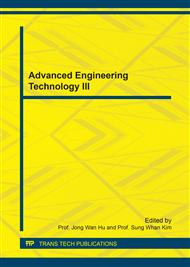[1]
H. Z. Cui, et al, Effect of lightweight aggregates on the mechanical properties and brittleness of lightweight aggregate concrete, Construct. Build. Mater. 35(10) (2012) 149-158.
DOI: 10.1016/j.conbuildmat.2012.02.053
Google Scholar
[2]
Q. L. Yang, K. S. Ma, The development of lightweight aggregate concrete, Railway Eng. 6 (2006) 104-106.
Google Scholar
[3]
S. Z. Liang, et al, The application and prospect of lightweight aggregate concrete in engineering, Shanxi Architect. 41(9) (2015) 104-105.
Google Scholar
[4]
M. D. Baker, et al, Comparison of Phosphorus Sorption by Light-Weight Aggregates Produced in the United States, Pedosphere, 24(6) (2014) 808-816.
DOI: 10.1016/s1002-0160(14)60068-0
Google Scholar
[5]
S. Y. Zhang, Research and development status of lightweight aggregate concrete, Shanxi Architect. 33 (2014) 107-108.
Google Scholar
[6]
M. E. Dilli, H. N. Atahan, C. Şengül, A comparison of strength and elastic properties between conventional and lightweight structural concretes designed with expanded clay aggregates, Construct. Build Mater. 101 (2015) 260-267.
DOI: 10.1016/j.conbuildmat.2015.10.080
Google Scholar
[7]
T. Lars, T. M. TorbjΦrn, H. Einar, Use of lightweight aggregate concrete gives a cheaper bridge. Proceedings 2nd International Symposium on Structure Lightweight Aggregate Concrete. (2000), 416-422.
Google Scholar
[8]
T. A. Holm, A. M. Vaysburd, Structural lightweight aggregate concrete performance, Concr. 33(10) (1992) 45-47.
Google Scholar
[9]
P. K. Mehta, Concrete structural, properties and materials, Tongji University, Shang Hai, (1991).
Google Scholar
[10]
Frank Dehn, Particular features on the production of lightweight aggregate concrete with open structure, LACER No. 3, (1998).
Google Scholar
[11]
W. Zeng, The Research on Preparation and Application of Lightweight Aggregate Concrete, Hunan University, Hunan, (2013).
Google Scholar
[12]
Fang, X. Z. Zhu, R. Li, History and Development of Lightweight Aggregate Concrete, Guide of Sci-tech Magazine, 23 (2010) 32.
Google Scholar
[13]
K. F. Meyer, L. F. Kahn, Lightweight Concrete reduce weight and increases span length of pretensioned concrete bridge girders, PCI J. 47(1) (2002) 68-75.
DOI: 10.15554/pcij.01012002.68.75
Google Scholar
[14]
X. U. Jinping, J. H. Chen, S. H. Zhou, Prospect and Application of Lightweight Aggregate, Concr. Sci. Technol. Overseas Build. Mater. 28(5) (2007) 11-13.
Google Scholar
[15]
J. F. Huo, Statas quo and development of research on lightweight aggregate concrete, Architect Technol. 40(4) (2009) 363-365.
Google Scholar
[16]
A. Souslikov, K. Kovler, Pre-soaked lightweight aggregates as additives for internal curing of high-strength concretes: Symposium on assessing early-age cracking of concrete, Cement, concrete and aggregates. 26(26) (2003) 1-8.
DOI: 10.1520/cca12295
Google Scholar
[17]
D. X. Fu, Lightweight aggregate concrete research status and prospects, China Build. Mater. Sci. Technol. 18(6) (2009) 47-51.
Google Scholar
[18]
P. Shafigh, M. Z. Jumaat, Mahmud, Oil palm shell as a lightweight aggregate for production high strength lightweight concrete, Construct. Build. Mater. 25(4) (2011) 1848-1853.
DOI: 10.1016/j.conbuildmat.2010.11.075
Google Scholar
[19]
O. Kayali, Fly ash lightweight aggregates in high performance concrete, Construct. Build. Mater. 22(12) (2008) 2393-2399.
DOI: 10.1016/j.conbuildmat.2007.09.001
Google Scholar


